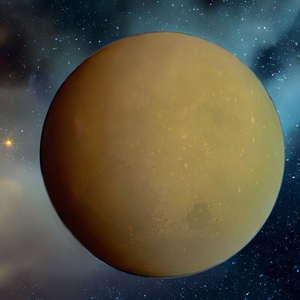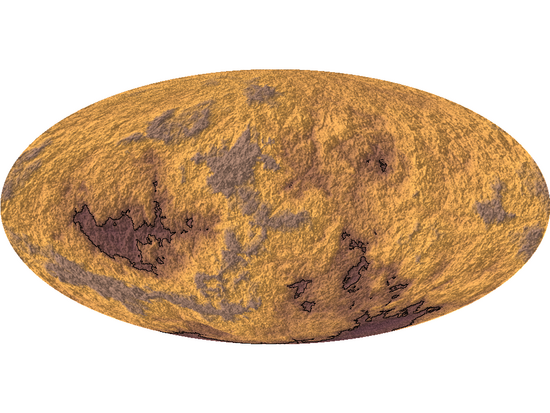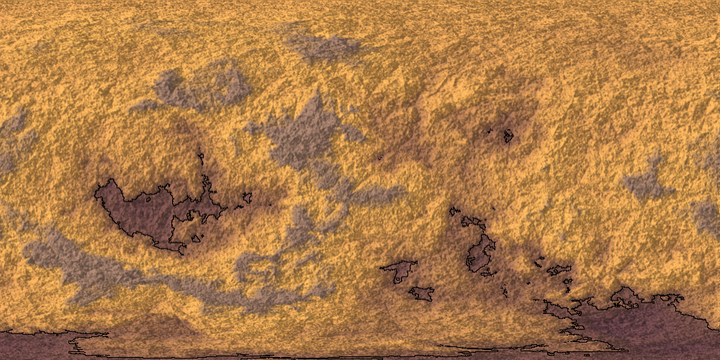Cyadon 2: Difference between revisions
No edit summary |
No edit summary |
||
| Line 66: | Line 66: | ||
Observations from the space probes have shown that Cyadon 2 has a permanent (intrinsic) magnetic moment independent of the Cyadon magnetic field. The permanent magnetic moment carves a part of space around Cyadon 2, creating a tiny magnetosphere embedded inside that of Cyadon; it is the only moon in the Tau Lanus System known to possess the feature. Its diameter is 2–3 Cyadon 2 radii. | Observations from the space probes have shown that Cyadon 2 has a permanent (intrinsic) magnetic moment independent of the Cyadon magnetic field. The permanent magnetic moment carves a part of space around Cyadon 2, creating a tiny magnetosphere embedded inside that of Cyadon; it is the only moon in the Tau Lanus System known to possess the feature. Its diameter is 2–3 Cyadon 2 radii. | ||
=== Climate === | |||
Cyadon 2's surface temperature is about 175 K (-98 °C). At this temperature, water ice has an extremely low vapor pressure, so the little water vapor present appears limited to the stratosphere. Cyadon 2 receives about 1% as much sunlight as Earth. Before sunlight reaches the surface, about 90% has been absorbed by the thick atmosphere, leaving only 0.1% of the amount of light Earth receives. | |||
Atmospheric methane creates a greenhouse effect on Cyadon 2's surface, without which Cyadon 2 would be much colder. Conversely, haze in Cyadon 2's atmosphere contributes to an anti-greenhouse effect by absorbing sunlight, cancelling a portion of the greenhouse effect and making its surface significantly colder than its upper atmosphere. | |||
== Colonization of Cyadon 2 == | |||
Revision as of 12:16, 2 May 2023
 | |
| Designations | |
|---|---|
| H3 Haven | |
| Orbital characteristics | |
| Periapsis | 664862 km |
| Apoapsis | 676938 km |
| 670900 km | |
| Eccentricity | 0.0094 |
| 3.551181 d (84 h, 302.400 s) | |
Average orbital speed | 15.334 km/s |
| Inclination | 0.34854° (to Cyadon's equator) |
| Satellite of | Cyadon |
| Physical characteristics | |
Mean radius | 1825 km |
| 41910000 km2 | |
| Volume | 2.53×1010 km3 |
| Mass | 8.931938×1022 kg |
Mean density | 1.942 g/cm3 |
| 1.352 m/s2 (0.138 g) (0.835 Moon's) | |
| 0.3414±0.0005(estimate) | |
| 2.641 km/s (0.236 Earth's) (1.11 Moon's) | |
| Synchronous | |
| Zero (to the orbital plane) | |
| Albedo | 0.22 |
| Temperature | 175.9 K (−97.2 °C) |
| 8.2 to 9.0 | |
| Atmosphere | |
Surface pressure | 121.3 kPa (1.2 atm) |
| Composition by volume | Variable
Stratosphere: 95.0% N2, 4.9% CH4; |
Cyadon 2, is the second closest satellit to Cyadon and ranks third in size among the satellites of Cyadon, is the only body in the Tau Lanus System besides Kelera for which the stable existence of liquid on the surface has been proven, and the only satellite of the planet with a dense atmosphere. There is a working colony on the satellite for the maintenance of an autonomous helium-3 extraction station located between the low orbit and the upper atmosphere of the ice (gas) giant Cyadon and further transportation of helium-3 on planet of Kelera.
Orbit and rotation
Cyadon 2 orbits Cyadon in just over three and a half days, with an orbital radius of about 670,900 km. With an orbital eccentricity of only 0.009. Like its fellow Cyadon satellites, Cyadon 2 is tidally locked to Cyadon, with one hemisphere of Cyadon 2 constantly facing Cyadon. Because of this, there is a sub-Cyadon point on Cyadon 2's surface, from which Cyadon would appear to hang directly overhead.
Bulk characteristics
Cyadon 2 has a mean radius of 1,825.3 km (1,131.7 mi) and a mass of 8.9319×1022 kg. It is a slight ellipsoid in shape, with its longest axis directed toward Cyadon. Based on its bulk density of 1.94 g/cm3, Cyadon 2's composition is half ice and half rocky material and silicate rock and iron, which is closer in bulk composition to the terrestrial planets than to other satellites of Cyadon. It is being the only moon of the Tau Lanus System with a magnetic field.
Cyadon 2 is partially differentiated into distinct layers with rocky center. This rocky center is surrounded by several layers composed of different crystalline forms of ice. Its interior may still be hot enough for a liquid layer consisting of a "magma" composed of water and ammonia between the ice Ih crust and deeper ice layers made of high-pressure forms of ice. The presence of ammonia allows water to remain liquid even at a temperature as low as 176 K (−97 °C)
Surface features
The surface of Cyadon 2 as complex, fluid-processed, and geologically young. Cyadon 2 has been around since the Tau Lanus System's formation, but its surface is much younger. Geological processes may have reshaped Cyadon 2's surface. Cyadon 2's atmosphere is four times as thick as Earth's, making it difficult for astronomical instruments to image its surface in the visible light spectrum. Cyadon 2's surface has an albedo of about 22 percent.
The first images revealed a diverse geology, with both rough and smooth areas. Examination has also shown the surface to be relatively smooth; the few objects that seem to be impact craters appeared to have been filled in, perhaps by raining hydrocarbons or volcanoes. Cyadon 2's surface is marked by broad regions of bright and dark terrain. The convoluted region is filled with hills and cut by valleys and chasms.
Most of the lakes are concentrated near the poles (where the relative lack of sunlight prevents evaporation), but several long-standing hydrocarbon lakes in the equatorial desert regions have also been discovered, including one near the working colony. The equatorial lakes are "oases", i.e. the supplier is underground aquifers.
Atmosphere and Magnetosphere
Cyadon 2 is the only known moon with a significant atmosphere, and its atmosphere is the only nitrogen-rich dense atmosphere in the Tau Lanus System aside from Kelera's. Observations from the space probes have shown that Cyadon 2's atmosphere is denser than Earth's and Kelera's, with a surface pressure about 1.21 atm. It is also about 1.19 times as massive as Earth's overall, or about 7.3 times more massive on a per surface area basis. Opaque haze layers block most visible light from the Star and other sources and obscure Cyadon 2's surface features. Cyadon 2's lower gravity means that its atmosphere is far more extended than Earth's and Kelera's. Cyadon 2's atmospheric composition is nitrogen (97%), methane (2.7±0.1%), and hydrogen (0.1–0.2%), with trace amounts of other gases. There are trace amounts of other hydrocarbons
Observations from the space probes have shown that Cyadon 2 has a permanent (intrinsic) magnetic moment independent of the Cyadon magnetic field. The permanent magnetic moment carves a part of space around Cyadon 2, creating a tiny magnetosphere embedded inside that of Cyadon; it is the only moon in the Tau Lanus System known to possess the feature. Its diameter is 2–3 Cyadon 2 radii.
Climate
Cyadon 2's surface temperature is about 175 K (-98 °C). At this temperature, water ice has an extremely low vapor pressure, so the little water vapor present appears limited to the stratosphere. Cyadon 2 receives about 1% as much sunlight as Earth. Before sunlight reaches the surface, about 90% has been absorbed by the thick atmosphere, leaving only 0.1% of the amount of light Earth receives.
Atmospheric methane creates a greenhouse effect on Cyadon 2's surface, without which Cyadon 2 would be much colder. Conversely, haze in Cyadon 2's atmosphere contributes to an anti-greenhouse effect by absorbing sunlight, cancelling a portion of the greenhouse effect and making its surface significantly colder than its upper atmosphere.

